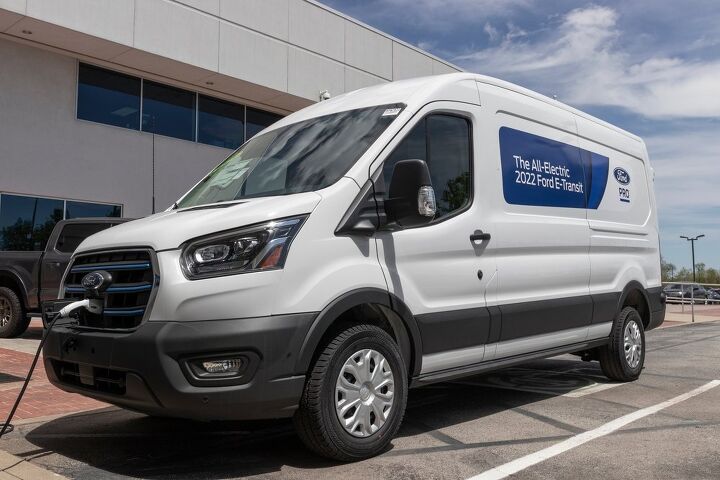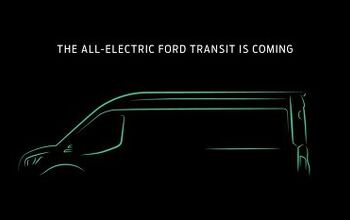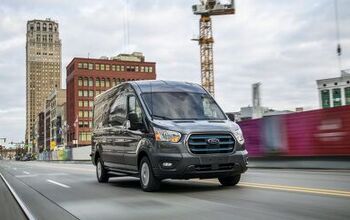Ford E-Transit Going Postal

The United States Postal Service (USPS) has announced an order for over 9,000 all-electric vans from the Ford Motor Company – presumably to help settle some of the drama surrounding the selected replacement for the venerable Grumman LLV.
Environmental regulators and the Biden administration had sought to encourage the Postal Service to embrace electric vehicles – which was part of the White House’s plan to transition government fleets away from internal-combustion engines. However, the USPS ultimately settled on Oshkosh Defense’s Next Generation Delivery Vehicle (NGDV).
While similar to the ancient Grumman LLV in terms of overall design and the fact that they’re both products fielded by defense contractors, the Oshkosh NGDV comes in four unique flavors split between battery electric, internal combustion, and whether or not the unit possesses all-wheel drive. But the USPS noted in 2021 (shortly after the contract was granted) that only about 10 percent of the fleet would end up being EVs. The stated reason, according to statements made by Postmaster General Louis DeJoy before the United States House of Representatives, was that the USPS would need several billion additional dollars to build the supportive infrastructure required to field a lot of EVs. There were likewise concerns that battery-powered vehicles would be a poor choice for extended routes and colder climates.
Electrified variants of the NGDV were also assumed to cost more upfront than gasoline-driven examples and it wasn’t even clear how long the lead-up time would be for Oshkosh to actually build them. So it prioritized the models that more closely resembled the venerable LLV. But you’ve probably noticed that your local post office doesn’t have many of those left. Despite living up to its namesake, the Grumman Long Life Vehicle ended up in use far longer than the government originally intended and had to be assisted by the occasional Mercedes Metris, Ford Transit, Ram ProMaster, or whatever else the USPS could get its hands on.
The Postal Service’s decision to buy 9,250 Ford E-Transits lays the groundwork to fulfill its December promise to add roughly 66,000 EVs into the mail fleet. With the Environmental Protection Agency, Biden administration, and corporate media all turning up the pressure, you could call this an appeasement. But it’s also fair to say that the USPS initially made it seem like it would be utilizing a lot more EVs than it eventually decided.
None of the vans are slated for active duty before December, as they have to be assembled in Kansas City and modified for the Postal Service. But they’ll be standard E-Transits internally – offering a 266-horsepower electric motor, rear-wheel drive, and a modest range of just 126 miles. As those forthcoming Fords will need a place to recharge overnight, the USPS has also confirmed it has ordered 14,000 charging stations from a trio of suppliers.
While it sounds as though the Postal Service has caved to the pressure, things are substantially more complicated.
As part of the E-Transit announcement, the USPS said it would likewise be purchasing an equal number of gasoline-powered vehicles from Stellantis – which is almost assuredly going to be the Ram ProMaster. Meanwhile, Congress passed a bill earmarking $50 billion in financial relief (over 10 years) for the USPS at the start of 2022. The White House followed up with an announcement of its own in December, stating that $3 billion in funding from the Inflation Reduction Act would go to the Postal Service so it could electrify 66,000 delivery vehicles and help the Biden administration keep its promise to eventually make all government vehicles EVs.
[Image: Jonathan Weiss/Shutterstock]
Become a TTAC insider. Get the latest news, features, TTAC takes, and everything else that gets to the truth about cars first by subscribing to our newsletter.

A staunch consumer advocate tracking industry trends and regulation. Before joining TTAC, Matt spent a decade working for marketing and research firms based in NYC. Clients included several of the world’s largest automakers, global tire brands, and aftermarket part suppliers. Dissatisfied with the corporate world and resentful of having to wear suits everyday, he pivoted to writing about cars. Since then, that man has become an ardent supporter of the right-to-repair movement, been interviewed on the auto industry by national radio broadcasts, driven more rental cars than anyone ever should, participated in amateur rallying events, and received the requisite minimum training as sanctioned by the SCCA. Handy with a wrench, Matt grew up surrounded by Detroit auto workers and managed to get a pizza delivery job before he was legally eligible. He later found himself driving box trucks through Manhattan, guaranteeing future sympathy for actual truckers. He continues to conduct research pertaining to the automotive sector as an independent contractor and has since moved back to his native Michigan, closer to where the cars are born. A contrarian, Matt claims to prefer understeer — stating that front and all-wheel drive vehicles cater best to his driving style.
More by Matt Posky
Latest Car Reviews
Read moreLatest Product Reviews
Read moreRecent Comments
- Amy I owned this exact car from 16 until 19 (1990 to 1993) I miss this car immensely and am on the search to own it again, although it looks like my search may be in vane. It was affectionatly dubbed, " The Dragon Wagon," and hauled many a teenager around the city of Charlotte, NC. For me, it was dependable and trustworthy. I was able to do much of the maintenance myself until I was struck by lightning and a month later the battery exploded. My parents did have the entire electrical system redone and he was back to new. I hope to find one in the near future and make it my every day driver. I'm a dreamer.
- Jeff Overall I prefer the 59 GM cars to the 58s because of less chrome but I have a new appreciation of the 58 Cadillac Eldorados after reading this series. I use to not like the 58 Eldorados but I now don't mind them. Overall I prefer the 55-57s GMs over most of the 58-60s GMs. For the most part I like the 61 GMs. Chryslers I like the 57 and 58s. Fords I liked the 55 thru 57s but the 58s and 59s not as much with the exception of Mercury which I for the most part like all those. As the 60s progressed the tail fins started to go away and the amount of chrome was reduced. More understated.
- Theflyersfan Nissan could have the best auto lineup of any carmaker (they don't), but until they improve one major issue, the best cars out there won't matter. That is the dealership experience. Year after year in multiple customer service surveys from groups like JD Power and CR, Nissan frequency scrapes the bottom. Personally, I really like the never seen new Z, but after having several truly awful Nissan dealer experiences, my shadow will never darken a Nissan showroom. I'm painting with broad strokes here, but maybe it is so ingrained in their culture to try to take advantage of people who might not be savvy enough in the buying experience that they by default treat everyone like idiots and saps. All of this has to be frustrating to Nissan HQ as they are improving their lineup but their dealers drag them down.
- SPPPP I am actually a pretty big Alfa fan ... and that is why I hate this car.
- SCE to AUX They're spending billions on this venture, so I hope so.Investing during a lull in the EV market seems like a smart move - "buy low, sell high" and all that.Key for Honda will be achieving high efficiency in its EVs, something not everybody can do.


































Comments
Join the conversation
Maybe this is a good use of golf cart technology. Short stops and starts. But not for a passenger vehicle that has to run 20-80% charge range (never mentioned in the amount that it diminishes the actual range of a golf cart by their manufacturers).
Even a blind squirrel finds a nut occasionally.... why the USPS went down the road of a bespoke vehicle, and an ICE one at that when plenty of commercially available products already exist I don't understand. TransitConnects and ProMaster City vans are both built in RHD configs for other markets and could easily be made available in the US on a fleet purchase. They're cheap, dependable, rugged and available. Clearly making no sense for the Post Office. For longer or larger routes, ICE or EV Transits. Sprinters or ProMasters are available in a huge range of configurations; short, mid and long wheelbases, low, mid and high roofs, etc. All three are available in RHD configurations as well. My local smaller market Post Office uses a Heinz 57 approach; LLV's, ProMasters, Caravans, MB Metris, MB Sprinter. Any would be a more cost effective and readily available alternative to having Grumman design, build and support a bespoke vehicle. But, it's the Post Office, who'd expect them to make a rational and practical business decision.